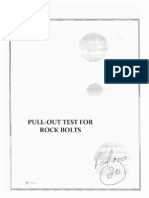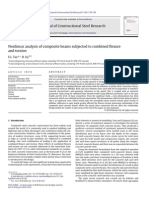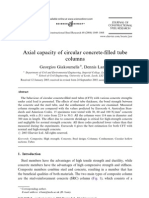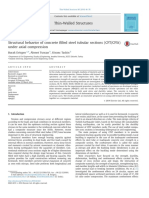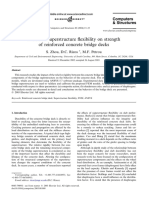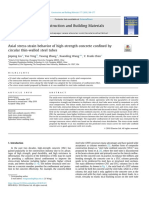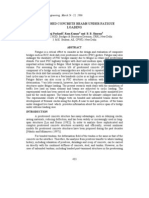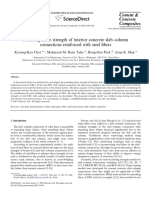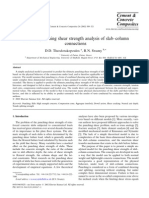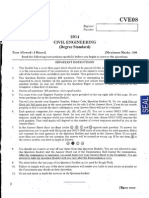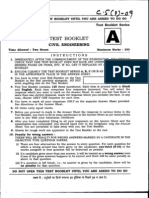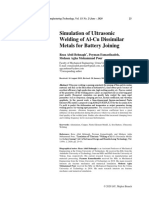Creep Modeling For Concrete-Filled Steel Tubes
Creep Modeling For Concrete-Filled Steel Tubes
Uploaded by
GunaCopyright:
Available Formats
Creep Modeling For Concrete-Filled Steel Tubes
Creep Modeling For Concrete-Filled Steel Tubes
Uploaded by
GunaOriginal Title
Copyright
Available Formats
Share this document
Did you find this document useful?
Is this content inappropriate?
Copyright:
Available Formats
Creep Modeling For Concrete-Filled Steel Tubes
Creep Modeling For Concrete-Filled Steel Tubes
Uploaded by
GunaCopyright:
Available Formats
Journal of Constructional Steel Research 59 (2003) 13271344 www.elsevier.
com/locate/jcsr
Creep modeling for concrete-lled steel tubes
Wassim Naguib a, Amir Mirmiran b,
a b
Simpson, Gumpertz & Heger Inc., 222 Sutter Street, Suite 300, San Francisco, CA 94108, USA North Carolina State University, Department of Civil Engineering, Raleigh, NC 27695-7533, USA Received 21 January 2003; received in revised form 12 May 2003; accepted 4 June 2003
Abstract Using the rate of ow method and the double power law function for basic creep of concrete, an algorithm is developed for the time-dependent behavior of concrete-lled steel tube (CFT), with or without the interface bond. The model adheres to geometric compatibility and static equilibrium, and considers the effects of sealed concrete, multi-axial state of stresses, creep Poissons ratio, stress redistribution, variable creep stress history, and creep failure of the column. The model is veried against previous creep tests for bonded and unbonded specimens. A study is then carried out on the practical design parameters that may affect creep of CFT columns under service loads, or lead to their creep rupture at high levels of sustained load. The study indicates that creep of CFT columns should be considered in the design, however, with creep coefcients much lower than those prescribed in the current ACI. Creep of CFT is shown to be a function of concrete mix, column geometry, and interface bond. Therefore, a single ultimate creep coefcient cannot be used for all concrete mixes, column geometries, and construction types. Bonded tubes curtail creep of concrete much more than the equivalent unbonded ones, mainly because of the stress relaxation phenomenon, which is more pronounced for smaller diameter-to-thickness ratios. For diameter-to-thickness ratios of 40 or less, bonded tubes are more durable in creep rupture than the equivalent unbonded ones. Creep rupture life of 75 years is quite feasible in bonded CFT, with diameter-to-thickness ratio of 40 or less, for sustained loads as high as 65% of the static capacity of the column. 2003 Elsevier Ltd. All rights reserved.
Keywords: Bond; Columns; Concrete-lled steel tube; Time-dependent behavior
Corresponding author. Tel.: +1-919-513-1735; fax: +1-513-1765. E-mail address: amirFmirmiran@ncsu.edu (A. Mirmiran).
0143-974X/$ - see front matter 2003 Elsevier Ltd. All rights reserved. doi:10.1016/S0143-974X(03)00085-3
1328
W. Naguib, A. Mirmiran / Journal of Constructional Steel Research 59 (2003) 13271344
Nomenclature a load distribution factor, or creep parameter for concrete Ac, As cross-sectional areas of concrete core and steel tube B column width D concrete core diameter s stress increment t time step e(t) total strain initial elastic secant mouldus E(to) Ec, Es modulus of elasticity of concrete core and steel tube eca, esa axial strains in concrete core and steel tube eca-uniaxial uniaxial creep strain in concrete core cr radial strain in concrete core dynamic modulus Ed EEffective effective modulus of elasticity asymptotic modulus for short duration of loading Eo es1, es2 axial and hoop strains in steel tube esa, esh axial and hoop strains in steel tube shrinkage strain eShr yield strain of steel tube esy lateral conning pressure fr fsa, fsh axial and hoop stresses in steel tube h column height J creep compliance function or creep strain per unit stress L loading span m, n creep parameters for concrete nc, nEPR static and effective Poissons ratio of concrete n Poissons ratio of steel s P total sustained axial load; Pc, Ps axial load on concrete core and steel tube PStatic static capacity of the column s applied stress t tube thickness age at loading to f (total) creep coefcient recoverable delayed elastic creep coefcient fd creep parameter for concrete f1 creep ow ff ultimate creep coefcient fu
W. Naguib, A. Mirmiran / Journal of Constructional Steel Research 59 (2003) 13271344
1329
1. Introduction Concrete-lled steel tube (CFT) combines the benets of two materials to provide high strength and ductility. Two types of construction are feasible: bonded (BCFT) or unbonded (UCFT). In BCFT, the tube and the concrete core both share the axial load, either by direct loading of the tube and concrete together, or through friction bond between the two. In UCFT, anti-friction material may be applied to the inner surface of the tube to eliminate any composite action under axial or lateral loads. The tube then provides only conning pressure for concrete. Some researchers, such as Orito et al. [1], have advocated that the tube in UCFT would be more resistant to outward buckling, and therefore, its conning effect may be utilized more efciently. While signicant work has been carried out on the shortterm static or dynamic behavior of CFT, less emphasis has been placed on its timedependent response. Creep effects have been accounted for by reducing either the strength or the initial elastic modulus of concrete [2,3]. Error in prediction of creep strains may lead to differential axial shortening, cracking, creep rupture, and creep buckling, all of which are of great concern in high-rise buildings [3,4]. The absolute amount of cumulative column shortening inuences the design of cladding details and the detailing of elevator rails, and vertical pipes, whereas the differential shortening between adjacent columns and walls may cause distortion of slabs [5]. Time-dependent behavior of CFT columns is markedly different from ordinary concrete columns in several aspects, as follows: 1. Concrete core is essentially sealed from migration of any moisture due to presence of the tube, and therefore, drying creep and shrinkage strains are considerably lower in CFT. 2. Connement of concrete by the tube offers resistance to the lateral expansion of concrete. This multi-axial stress effect does not allow concrete to freely creep in the axial direction. 3. Stress transfer between concrete core and steel tube is possible in BCFT, resulting in stress relaxation of concrete, and further reducing its creep. 4. As a result of stress relaxation in concrete, even though the total axial load on the column may be constant, stresses in each component (steel and concrete) may vary signicantly over time. This variation must be accounted for in the creep analysis. This paper evaluates the effect of these issues on creep modeling of CFT columns. It veries the proposed model against experimental data, and provides results of a parametric study on creep of CFT columns under service loads, as well as creep rupture of CFT columns at high levels of sustained load. 2. Literature review Terrey et al. [3] considered time-dependent behavior of concrete encased in a steel section as an area that requires further exploration. Most recently, Ichinose et al.
1330
W. Naguib, A. Mirmiran / Journal of Constructional Steel Research 59 (2003) 13271344
[4] pointed out the scarce literature on the creep phenomenon in composite steelconcrete structures. Experiments by Terrey et al. [3] showed the moisture egress from encased concrete to be very small or totally eliminated. As such, shrinkage of concrete core may be safely neglected, and creep coefcients may be 5060% of those in ordinary concrete. Ichinose et al. [4] also reported a series of tests to obtain creep coefcients in composite steel-concrete columns. Uy and Das [6] studied creep and shrinkage of concrete in a fabricated steel box column typically used in tall buildings. They used an age-adjusted effective modulus method (AEMM) to simulate the construction of individual oor levels in a building. Morino et al. [7] reported on creep tests of square CFT columns, including six concentrically loaded stubs with width-to-thickness B/t ratios from 23 to 47 and height-to-width h/B ratios from 2:1 to 12:1; one beam with a B/t ratio of 33 and span-to-depth L/B ratio of 26; and two eccentrically loaded columns both with B/t ratio of 33 and h/B ratio of 8:1. Although they did not make a conclusive statement regarding the length effect on creep behavior of CFT columns, they noted a clear reduction in the creep coefcient of concrete core, due mainly to the stress redistribution between concrete and steel. They further questioned whether creep coefcient is a function of the loading condition, and emphasized the need to develop a uniform method for time-dependent analysis of CFT columns. Bradford and Wright [8] developed a model to study the long-term behavior of lightweight concrete core in thin steel sheeting typical of that encountered in a composite proled wall. Under sustained loads, concrete creeps and shrinks, producing compressive stresses in steel that increase over time, and may eventually be large enough to precipitate its local buckling.
3. Analytical modeling 3.1. Creep model for concrete Of the number of creep models available for concrete [9], the effective modulus method (EMM) is the simplest and the oldest, consisting only of a single linear elastic solution, as EEffective E(to) 1 J(t,to) 1 (t,to) (1)
where J is the creep compliance function, i.e. creep strain per unit stress, to is the age at loading, E(to) is the initial modulus of elasticity, and f is the creep coefcient. Total strain in concrete at any time can then be calculated as e(t)
J(t,to)ds(to) eShr
(2)
to
where s(to) is the applied stress and eShr is the shrinkage strain. To account for aging
W. Naguib, A. Mirmiran / Journal of Constructional Steel Research 59 (2003) 13271344
1331
effects and stress variations, an age-adjusted effective modulus method (AEMM) was introduced, which also follows a single linear elastic solution. The rate of creep method (RCM), on the other hand, is based on a rst-order differential equation, and accounts for any stress history. However, it results in parallel creep curves and overestimating of the creep recovery, because rate of creep is considered independent of the loading age. The rate of ow method (RFM) by Bazant and Wittmann [9] and England and Illston [10] addresses most of these deciencies by combining the EMM and RCM, using a two-part creep compliance function as J(t,to) 1 1 j(t,to) jf(t)jf(to) E(to) Ed E(to) (3)
where the total creep coefcient f consists of an irrecoverable creep ow ff and a recoverable delayed elastic component fd, as j(t,to) E(to)J(t,to)1 jf(t) jd. (4)
The delayed elastic component, which is independent of the loading age, is represented by a ctitious effective modulus, also termed as dynamic modulus Ed, given by Ed E(to) . 1 d (5)
Previous research has shown that the delayed creep strains are identical for different concrete mixes [11]. Nielson [12] suggested a value of 0.333 for fd. The assumption of a constant fd simplies the integration process, but leads to a kink in the early phase of the creep curve. Use of the double power law function, as will be discussed later, for the creep ow ff at the early ages in RFM alleviates the problem and results in a smooth creep curve. Once the value of ff exceeds zero, the RFM can proceed with the constant fd of 0.333. The initial elastic modulus E(to) is the secant mouldus calculated shortly after applying the load based on a short-term stressstrain model for concrete. In the present study, connement model of Ahmad and Shah [13] is used, which suggests an incremental-iterative process for the passive connement developed by the steel tube. 3.2. Effect of sealed concrete Creep of concrete consists of two components: basic and drying. The drying creep is related to the moisture egress from concrete. Neville [14] showed that concrete, while still drying, creeps more than both the wet (fresh) concrete and the already dry (old) concrete, since in the latter two cases the drying component of creep does not take place. The pores of sealed concrete are either coated with epoxy or encased in a tube, thus preventing or signicantly reducing its shrinkage and drying creep. Russell and Corely [15] showed that creep of sealed concrete might be half as much as that of the exposed concrete, under the same sustained loads and when loaded at the same age.
1332
W. Naguib, A. Mirmiran / Journal of Constructional Steel Research 59 (2003) 13271344
3.3. Double power law for basic creep of concrete The RFM requires a creep prediction curve for the specic mix of concrete [9]. The double power law describes the basic creep of sealed or encased concrete, for which the drying creep component could be neglected [16]. The creep compliance function J(t, to) is expressed as J(t,t0) 1 1 m n ( t o )(tto) Eo Eo (6)
where Eo is the asymptotic modulus for short duration of loading, and f1, a, m, and n are all functions of concrete mix proportions and the 28-day compressive strength of concrete. Effect of different concrete mixes on creep parameter n is shown in Table 1 after Freudenthal and Roll [17]. The various mixes shown in the table are used later in the model validation and the parametric study. 3.4. Effect of multi-axial stresses and creep Poissons ratio Net creep strain of concrete under multi-axial stresses is less than that under uniaxial stress of the same magnitude [18]. Gopalakrishnan et al. [18] and Jordaan and Illston [19] have shown that despite anisotropy and creep nonlinearity, creep strain in concrete conforms to the principle of superposition by adding creep strain in each direction caused by each stress component acting separately. Gopalakrishnan et al. elastic lateral , creep Poissons [18] dened three Poissons ratios: static or elastic elastic axial creep lateral total lateral , and effective Poissons ratio or EPR . ratio or CPR creep axial total axial Under triaxial loading with unequal principal stresses, creep Poissons ratio is largest in the direction of the smallest stress. Gopalkrishnan et al. [18] showed the
Table 1 Concrete mix proportions and creep parameters [17] Mix number Mix ratio (cement to aggregates) Mix proportion by weight Compressive strength MPa Creep parameter (n)
Cement 1 2 3 4 5 6 7 1: 1: 1: 1: 1: 1: 1: 2.5 4 4 4.5 4.5 6 7 1.0 1.0 1.0 1.0 1.0 1.0 1.0
Water 0.450 0.500 0.490 0.500 0.375 0.525 0.500
Sand 1.0 1.6 1.6 2.4 1.8 2.4 3.5
Gravel 1.5 2.4 2.4 2.0 2.8 3.6 3.5 43 38 52 29 45 35 29 0.170 0.138 0.178 0.124 0.145 0.124 0.120
W. Naguib, A. Mirmiran / Journal of Constructional Steel Research 59 (2003) 13271344
1333
effective Poissons ratio to be constant over time for both biaxial and triaxial loadings, with its value ranging from 0.09 to 0.17, somewhat less than the case of uniaxial loading, which is in the range of 0.170.22. Jordaan and Illston [19] also studied time-dependent effects on the Poissons ratio for sealed concrete under variable multi-axial state of stresses, and concluded that the effective Poissons ratio remains approximately constant over time and is equal to its static value. The differences and variations observed in other tests, they argued, are not so great as to exclude the possibility of forming a suitable method for calculating creep in most engineering applications. Therefore, the normal constitutive relations for concrete under multi-axial state of stresses can be adopted for the elastic strains, and creep strains in any direction can be computed using the principle of superposition and a creep constitutive equation similar to those for elastic strain. The axial creep strain in a laterally conned concrete can be written as ca ca-uniaxial2ncJ(t,to)fr (7)
where eca-uniaxial is the creep strain from the uniaxial RFM, nc is the static Poissons ratio, as discussed above, and fr is the lateral conning pressure on concrete. The radial creep strain in concrete can be calculated using the effective Poissons ratio, nEPR as cr nEPRca. 3.5. Effect of stress relaxation and redistribution Stress redistribution in hybrid systems results in stress relaxation for the component with higher creep potential. In order to account for the variable creep stresses in concrete with no signicant drying creep, Boltzmann principle of superposition may be used [9]. Accordingly, strain due to any stress history may be obtained by integrating the response to small stress increments (s) applied at small time intervals (t), as (t) 1 [J(t ,t ) J(tr,tq-1)] (tq) shr 2 r q q1 (8)
(9)
where subscripts r and q refer to small time steps for the numerical integration. 3.6. Failure criterion Failure of CFTs under short-term (static) or long-term (creep) loading occurs when strains in the tube exceed the yielding strain of steel. Long-term failure, termed here as creep rupture is based on total creep strains in the tube. In UCFT, the tube is only subjected to hoop strains, and therefore, a uniaxial failure criterion sufces, as given by s2 sy (10)
1334
W. Naguib, A. Mirmiran / Journal of Constructional Steel Research 59 (2003) 13271344
where es2 is the hoop strain in the tube, and esy is the yield strain of steel tube. The tube in BCFT is subjected to biaxial stresses, for which von Mises yielding criterion is considered, as given by ( s2 s1s2 s1 2 ) ( )2 2 1 sy sy sy (11)
where es1 is the axial strain in the tube. 3.7. Modeling requirements Two major requirements for creep modeling of CFT are as follows (see Fig. 1): (a) Static equilibrium: In UCFT, only the equilibrium in the hoop direction needs to be satised, as fr 2fst D (12)
where fs is the hoop stress in the tube, t is the tube thickness, and D is the core diameter. In BCFT, equilibrium in the axial direction must also be satised at each time step, as P Pc Ps (13)
where P is the total sustained axial load on the section, and Pc and Ps are the contributions from the concrete core and steel tube, respectively. Therefore, axial stress in concrete remains constant in UCFT, whereas in BCFT it changes over time. (b) Strain compatibility: In UCFT, the only condition is that hoop strain in the tube must be equal to the radial strain in the concrete core, or else a gap will be developed between the two materials. In BCFT, one needs to also satisfy the axial strain compatibility, assuming perfect bond between the tube and the concrete core in the axial direction. 3.8. Creep algorithm Based on the above discussion, an algorithm was developed for the time-dependent analysis of both BCFT and UCFT. The following steps are used in the analysis: 1. Short-term (static) strains and stresses are determined at time to based on the above conditions. In UCFT, concrete takes the entire axial load. On the other hand, in BCFT, a load distribution factor (a) is assumed such that Pc aP, and Ps PPc (14)
where an initial estimate of a can be simply based on the stiffness ratio of the section, as
W. Naguib, A. Mirmiran / Journal of Constructional Steel Research 59 (2003) 13271344
1335
Fig. 1.
Creep mechanism in UCFT and BCFT columns.
EcAc EcAc EsAs
(15)
where E and A designate the modulus of elasticity and cross-sectional area, respectively, and subscripts c and s denote concrete and steel, respectively. Once
1336
W. Naguib, A. Mirmiran / Journal of Constructional Steel Research 59 (2003) 13271344
the axial load is known (or assumed) in concrete, using the iterative procedure of Ahmad and Shah [13], the hoop stress in the tube is calculated such that it satises static equilibrium and strain compatibility in the hoop direction. It should be noted that the assumption of strain compatibility in the hoop direction may be questionable in UCFT due to the higher Poissons ratio of steel in its elastic range. However, due to the load redistribution algorithm of the model the difference is expected to be negligible. The axial strain in the tube esa can then be calculated as esa fsa fsh n Es sEs (16)
2. 3.
4. 5. 6. 7.
8.
where fsa and fsh are the axial and hoop stresses in the tube, respectively, and ns is the Poissons ratio of steel. Note that fsa in UCFT is zero, and tensile hoop strain is considered negative. While this essentially concludes short-term analysis of UCFT, for BCFT another level of iteration must be carried out for a, until the difference between the axial strains in steel and concrete falls within the preset tolerance. Once convergence is achieved, the effective Poissons ratio of concrete nEPR is taken as the ratio of radial to axial strain in concrete core, and is kept constant throughout the time-dependent analysis. The time step is incremented by a preset value of t. Using the RFM and the double power law, the uniaxial creep strain potential of concrete is estimated based on the current level of axial stress in concrete. In BCFT, it is necessary to account for the varying stresses in concrete by the principle of superposition. In UCFT, however, axial stress in concrete remains constant. Axial creep strain in concrete is modied for the effect of multi-axial stresses using Eq. (7). Radial creep strain in concrete is calculated using nEPR and Eq. (8). Axial and lateral strains in the steel tube are calculated independently from concrete, taking into account the Poissons ratio of steel. In BCFT, axial strains in concrete eca and steel esa are compared, and if the difference is larger than the preset tolerance, the axial stress in the tube is adjusted to maintain static equilibrium, taking into account the biaxial state of stress in the tube. In essence, a stress relaxation takes place, whereby concrete is relieved from part of its axial stress. Previous experiments by Morino et al. [7] have shown that the axial stress variation in the tube may be in the order of 1020% of the initial stress, whereas stresses in concrete may vary about 510%. Steps 4 to 7 are repeated until convergence is achieved. In both BCFT and UCFT, radial strain in concrete ecr is compared with the hoop strain in steel esh, and if the difference is greater than the preset tolerance, hoop strain in the tube is adjusted and a new connement pressure fr is calculated. Steps 4 to 8 are then repeated until convergence is achieved. Upon convergence, failure of the tube is examined, according to Eq. (10) for uniaxial stresses in UCFT and Eq. (11) for biaxial stresses in BCFT. If failure has occurred, the procedure would stop. Otherwise, steps 2 to 9 will be repeated for the duration of sustained loads. Before embarking on a new time step, the varying creep stress
W. Naguib, A. Mirmiran / Journal of Constructional Steel Research 59 (2003) 13271344
1337
in concrete fca is determined to allow for time integral of creep strains based on the principle of superposition. More details on the analytical procedure can be found in Naguib [20].
4. Model validation The proposed model was validated against the experimental data of Terrey et al. [3] for a BCFT and a UCFT specimen, both of which with 600 mm height and 196 mm inside diameter, and a concrete core of 45.2 MPa. The tube thickness in BCFT and UCFT specimens was 1.5 and 1 mm, respectively, representing a D/t ratio of 130 and 196, respectively. The inside surface of the UCFT was greased to prevent any friction bond between steel and concrete. Both specimens were loaded 18 days after casting with a sustained load of 350 kN for approximately 100 days. Based on the information on the mix and strength of concrete, a creep parameter n of 0.147 was assumed for modeling of concrete. Fig. 2 shows comparison between the experiment and the model for the total strains in concrete and steel in the UCFT specimen. The predicted strains in the tube were adjusted for the temperature variation of 10 C during the creep tests. The analytical curves are parallel to the experimental ones. The model slightly overestimates strains in concrete, while underestimating those in the tube. This may be attributed to (a) some stress transfer between steel and concrete, as perfect debonding may not exist at the interface, and (b) difference in prediction of elastic strains using the connement model of Ahmad and Shah [13]. Fig. 3 shows a comparison between the creep coefcients calculated for the test data and the proposed model. The creep coefcient is dened as the ratio of the net creep strain to the elastic strain, as
Fig. 2.
Creep strains for UCFT specimencomparison of model and experiments.
1338
W. Naguib, A. Mirmiran / Journal of Constructional Steel Research 59 (2003) 13271344
Fig. 3. Creep coefcients for UCFT specimencomparison of model and experiments.
TotaleElastic . eElastic
(17)
The gure also shows creep curves of ACI 209 [21] for two different ultimate creep coefcients fu of 1.2 and 1.45. The ACI 209 creep model follows a power law function, as j(t,to) ju(to) (tto)0.6 10 (tto)0.6 (18)
where ACI 209 suggests fu in the range of 1.3 to 4.15, with a typical value of 2.35 for ordinary concrete. The gure shows that creep of UCFT is much less than that of conventional concrete. The difference between the coefcient of 1.2 that matches the experiments and the coefcient of 1.45 that matches the model is considerably less than the usual range of variations for creep coefcients in concrete. The difference is due mainly to the difference in the elastic strain of concrete, which is slightly underestimated by the connement model of Ahmad and Shah [13]. Although the model of Ahmad and Shah [13] was calibrated using a number of tests including small-scale CFTs, most of its applications are in conventional reinforced concrete columns. Fig. 4 shows the total creep strains for the BFCT specimen along with the predicted strains from the proposed model. Also shown in the gure is the total creep strains calculated using the AEMM by Terrey et al. [3]. A good agreement is noted in the trend of the creep curve. The difference is again in predicting the initial elastic strain. Fig. 5 shows a comparison between the creep coefcients calculated for the test data and the proposed model. In the gure, creep curves of ACI 209 [21] are also shown for two different ultimate creep coefcients of 1.2 and 1.0, of which the former matches the test data and the latter matches the model. The difference in the creep coefcient is again due to the initial elastic strain in concrete [13], as described
W. Naguib, A. Mirmiran / Journal of Constructional Steel Research 59 (2003) 13271344
1339
Fig. 4.
Creep strains for BCFT specimencomparison of model and experiments.
Fig. 5.
Creep coefcients for BCFT specimencomparison of model and experiments.
above. Otherwise, the net creep strains appear to be in good correlation with the experiments, as the creep curves in Fig. 4 are parallel to each other. Nakai et al. [22] also tested three specimens with 1 m height, outside diameter of 165.2 mm and tube thickness of 0.0 (i.e. with no tube), 4.5, 5.0 mm, respectively. The specimens were lled with 29.4 MPa concrete, and tested for 6 months under a sustained stress of 7.85 MPa. Their suggested creep coefcient of 1.441.60 for CFT is compared with the proposed model in the next section. 5. Parametric study Using the above model, a parametric study was carried out on the practical design factors that may affect long-term behavior of CFT for creep under service loads and for creep rupture.
1340
W. Naguib, A. Mirmiran / Journal of Constructional Steel Research 59 (2003) 13271344
Fig. 6.
Effect of tube thickness and concrete mix on creep of UCFT columns.
5.1. Creep under service loads The equivalent ultimate creep coefcient fu for CFT is calculated using Eq. (18) with the least square method, such that the ACI 209 [21] creep curve provides the best t to the predicted creep. Figs. 6 and 7 show the ultimate creep coefcients for UCFT and BCFT, respectively, for different concrete mixes and column cross-sections. The mix is identied by creep parameter n, which is varied between 0.12 and 0.178 (see Table 1). The larger the n value, the greater is the creep of concrete. The cross-section of the column is identied by D/t ratio. The gures also show the suggested creep coefcients of Terrey et al. [3] and Nakai et al. [22] at their respective D/t ratios. The following observations can be made: For the same concrete mix and creep parameter n, regardless of the interface bond
Fig. 7. Effect of tube thickness and concrete mix on creep of BCFT columns.
W. Naguib, A. Mirmiran / Journal of Constructional Steel Research 59 (2003) 13271344
1341
or lack of it, creep coefcient increases as D/t ratio increases. Creep of CFT is asymptotically bounded by fu-Sealed for a sealed concrete of the same mix with no steel jacket (D / t), and zero for an all steel column (D / t0). For the same concrete mix and creep parameter n and column geometry D/t, BCFT curtails creep of concrete much more than UCFT. Effect of D/t ratio is much more pronounced in BCFT, where stress redistribution can relieve concrete from some of its creep stresses. On the other hand, the tube in UCFT can only conne lateral expansion of concrete, while creep stresses in concrete remain constant. The proposed model is in general agreement with the suggested creep coefcients of previous studies [3,22]. However, the notion that a single creep coefcient can be applied to any concrete mix, column geometry, and interface bond is not appropriate. 5.2. Creep rupture Creep rupture life of CFT is dened as the service life (time in years) that it takes for the column to develop yielding in the tube under sustained loads. As discussed earlier, failure in UCFT is uniaxial, whereas it follows the von Mises criterion in BCFT. Figs. 8 and 9 show the estimated creep rupture life of UCFT and BCFT, respectively, for one concrete mix No. 2 (n = 0.14), grade 60 steel tube (414 MPa yield), and different D/t ratios, as function of P/PStatic, where P is the sustained load and PStatic is static capacity of the column. Following observations can be made: UCFT columns with thicker tubes are much less durable for creep rupture, because their static capacity is increased, without any stress redistribution that can relieve concrete from its creep stress. Creep rupture life of 75 years at 50% of static capacity is not feasible for UCFT with D/t ratios of less than 80.
Fig. 8.
Estimated creep rupture life of UCFT columns.
1342
W. Naguib, A. Mirmiran / Journal of Constructional Steel Research 59 (2003) 13271344
Fig. 9.
Estimated creep rupture life of BCFT columns.
BCFT columns with thicker tubes are much more durable for creep rupture. This is due to the larger stress relaxation that can occur in concrete. Creep rupture life of 75 years is quite feasible for D/t ratios of 40 or less, at even 65% of static capacity. A comparison of estimated creep rupture life for UCFT and BCFT is shown in Fig. 10, as function of absolute value of sustained load, normalized as P/fcAc, where fc is the 28-day compressive strength of concrete and Ac is the area of concrete core. The gure shows that for D/t ratios of less than 40, BCFT is much more durable than its equivalent UCFT. Moreover, creep rupture life of both types of column generally increases for smaller D/t ratios.
Fig. 10. Comparison of estimated creep rupture life of UCFT and BCFT columns.
W. Naguib, A. Mirmiran / Journal of Constructional Steel Research 59 (2003) 13271344
1343
6. Conclusions Using the rate of ow method and the double power law creep function, an algorithm is developed for the creep of CFT columns by adhering to the strain compatibility and static equilibrium. The proposed model shows good agreement with previous creep tests on bonded and unbonded CFT. The study indicates that creep of CFT columns should be considered in the design, however, with creep coefcients much lower than those prescribed in the current ACI 209 [21]. A study on the effect of practical design parameters revealed the following: Creep of CFT is a function of concrete mix, column geometry, and interface bond. The notion that a single creep coefcient can be used for all concrete mixes and column geometries and types of construction is not appropriate. Creep of CFT is asymptotically bounded by fu-Sealed for a sealed concrete of the same mix with no steel jacket (D / t), and zero for an all steel column (D / t0). BCFT curtails creep of concrete much more than UCFT. This is due to the stress relaxation of concrete, which is more pronounced for smaller D/t ratios. For the same magnitude of sustained loads, BCFT is much more durable for creep rupture than its equivalent UCFT for D/t ratios of 40 or less.
Acknowledgements This study is an extension of the rst authors dissertation on long-term behavior of concrete-lled ber reinforced polymer (FRP) tubes, which was supported by the National Science Foundation CAREER award to the second author. Findings and opinions expressed here are those of the authors alone and not necessarily those of the sponsoring agency.
References
[1] Orito Y, Sato T, Tanaka N, Watanabe Y. Study on the unbonded steel tube structure. In: Proceedings of International Conference on Composite Construction in Steel and Concrete, ASCE. 1987. p. 786804. [2] Rangan BV. Design of slender hollow steel columns lled with concrete. In: Proceedings of ICSAS91, Singapore. 1991. p. 10412. [3] Terrey PJ, Bradford MA, Gilbert RI. Creep and shrinkage in concrete-lled steel tubes. In: Grundy P, Holgate A, Wong SM, editors. Tubular Structures VI. Rotterdam, Netherlands: Balkema; 1994. p. 2938. [4] Ichinose LH, Watanabe E, Nakai H. An experimental study on creep of concrete lled steel pipes. Journal of Constructional Steel Research 2001;57(4):45366. [5] Ghosh SK. Differential shortening in tall concrete buildings. In: Proceedings of the 15th Structures Congress, ASCE, Portland, OR. 1997. p. 1359. [6] Uy B, Das S. Time effects in concrete-lled steel box columns in tall buildings. Journal of Structural Design of Tall Buildings 1997;6(1):122.
1344
W. Naguib, A. Mirmiran / Journal of Constructional Steel Research 59 (2003) 13271344
[7] Morino S, Kswaguchi J, Cao ZS. Creep behavior of Concrete-lled steel tubular members. In: Proceedings of Engineering Foundation Conference on Composite Construction in Steel and Concrete III, Irsee, Germany, ASCE. 1997. p. 51425. [8] Bradford MA, Wright HD. Time-dependent local buckling in thin-walled lightweight composites. Journal of Constructional Steel Research 1998;46(1-3):221. [9] Bazant ZP, Wittmann FH. Creep and shrinkage in concrete structures. New York: John Wiley & Sons, 1980. [10] England GL, Illston JM. Methods of computing stress in concrete from a history of measured strain. Civil Engineering and Public Works Review 1965;60(4):5137. [11] Illston JM. Components of creep in mature concrete. ACI Journal 1968;65(3):21928. [12] Nielson LF. Kriechen und relaxation des betons. Beton, Stahlbeton 1970;65:2725 In German. [13] Ahmad SH, Shah SP. Complete triaxial stress-strain curves for concrete. Journal of Structural Engineering, ASCE 1982;108(4):72842. [14] Neville AM. Creep of concrete: Plain, reinforced and prestressed. Amsterdam: North-Holland Publishing Company, 1970. [15] Russel HG, Corley WG. Time-dependent behavior of columns in water tower place. Research and Development Bulletin RD025B, Portland Cement Association, 1977. [16] Bazant ZP, Osman E. Double power law for basic creep of concrete. Materials and Structures 1976;9(49):311 RILEM, Paris. [17] Freudenthal AM, Roll F. Creep and creep-recovery of concrete under high compressive stresses. ACI Journal 1958;54(12):111142. [18] Gopalakrishnan KS, Neville AM, Ghali A. A hypothesis on mechanism of creep concrete with reference to multiaxial compression. ACI Journal 1970;67(3):2935. [19] Jordaan IJ, Illston JM. Time-dependent strains in sealed concrete under multiaxial compressive stress. Magazine of Concrete Research 1971;23(75-76):7988. [20] Naguib W. Long-term behavior of hybrid FRP-concrete beam-columns. PhD thesis, University of Cincinnati, Cincinnati, OH, 2001. [21] ACI Committee 209. Prediction of creep, shrinkage and temperature effects in concrete structures. ACI 209 R-92, ACI, SP-70, 1992. [22] Nakai H, Kurita A, Ichinose LH. An experimental study on creep of concrete-lled steel pipes. In: Proceedings of International Conference on Composite Construction in Steel and Concrete, Fukuoka, Japan. 1991. p. 5560.
You might also like
- Reinforced Concrete Buildings: Behavior and DesignFrom EverandReinforced Concrete Buildings: Behavior and DesignRating: 5 out of 5 stars5/5 (1)
- Pull Out Test For Rock BoltsDocument12 pagesPull Out Test For Rock BoltsGuna95% (19)
- Smith Et al-1958-AIChE Journal PDFDocument3 pagesSmith Et al-1958-AIChE Journal PDFAlastairNo ratings yet
- Physics Round 1 MechanicsDocument6 pagesPhysics Round 1 Mechanicsহাবিব রহমানNo ratings yet
- Thermodynamics Project: TOPIC: Fugacity of Pure SubstancesDocument6 pagesThermodynamics Project: TOPIC: Fugacity of Pure SubstancesRaman K. Bedi100% (1)
- Creep Modeling For Concrete-Filled Steel Tubes: Wassim Naguib, Amir MirmiranDocument18 pagesCreep Modeling For Concrete-Filled Steel Tubes: Wassim Naguib, Amir Mirmiransaber javidNo ratings yet
- 1 s2.0 S2090123215000788 MainDocument14 pages1 s2.0 S2090123215000788 MainRaja GopalNo ratings yet
- Advances in Civil Engineering Tests of Inclined Concrete - Filled Steel Tubular Stub Columns Under Vertical Cyclic LoadingDocument12 pagesAdvances in Civil Engineering Tests of Inclined Concrete - Filled Steel Tubular Stub Columns Under Vertical Cyclic LoadingChayanon HansapinyoNo ratings yet
- Analysis and Modelling of CFT Members Moment Curvature AnalysisDocument10 pagesAnalysis and Modelling of CFT Members Moment Curvature AnalysisMahdi ValaeeNo ratings yet
- Seismic Behavior of Steel Beam and Reinforced Concrete Column ConnectionsDocument20 pagesSeismic Behavior of Steel Beam and Reinforced Concrete Column Connectionsjuan carlosNo ratings yet
- Strength of Concrete Filled Tubular ColumnDocument10 pagesStrength of Concrete Filled Tubular ColumnJitendraNo ratings yet
- Journal of Constructional Steel Research: E.L. Tan, B. UyDocument10 pagesJournal of Constructional Steel Research: E.L. Tan, B. UyvenkatesanjsNo ratings yet
- Literature Review: 2.1 PreambleDocument26 pagesLiterature Review: 2.1 PreambleamokeNo ratings yet
- Analytical Model For Predicting Axial Capacity and Behavior of Concrete Encased Steel Composite Stub ColumnsDocument10 pagesAnalytical Model For Predicting Axial Capacity and Behavior of Concrete Encased Steel Composite Stub Columnsanon_47684961No ratings yet
- Print Axial Capacity of Circular Concrete-Filled Tube ColumnsDocument20 pagesPrint Axial Capacity of Circular Concrete-Filled Tube ColumnsMona MahmoudNo ratings yet
- Published Journal Can Be Given As ReferenceDocument15 pagesPublished Journal Can Be Given As ReferenceSREEKUMARA GANAPATHY V S stellamaryscoe.edu.inNo ratings yet
- Bond Behavior in Concrete-Filled Steel TubesDocument13 pagesBond Behavior in Concrete-Filled Steel TubesKhanh Tran QuocNo ratings yet
- Ding 2011Document11 pagesDing 2011Yahia Raad Al-AniNo ratings yet
- 15-Performance of Concrete-Filled Thin-Walled Steel Tubes Under Pure Torsion 2007 PDFDocument13 pages15-Performance of Concrete-Filled Thin-Walled Steel Tubes Under Pure Torsion 2007 PDFHendrik TaupanNo ratings yet
- Paper 033 CNDocument32 pagesPaper 033 CNLeroyNo ratings yet
- Thin-Walled Structures: Burak Evirgen, Ahmet Tuncan, Kivanc TaskinDocument11 pagesThin-Walled Structures: Burak Evirgen, Ahmet Tuncan, Kivanc Taskinjust meNo ratings yet
- Composite Concrete Slabs With Profiled SDocument13 pagesComposite Concrete Slabs With Profiled SramiNo ratings yet
- Evalution of Creep in CFST MemberDocument0 pagesEvalution of Creep in CFST MemberGunaNo ratings yet
- 1 s2.0 S0141029617323829 MainDocument17 pages1 s2.0 S0141029617323829 MainAnonymous cKV7P2magXNo ratings yet
- 1Document13 pages1ihpeterNo ratings yet
- Copy First Phase Report MSDocument39 pagesCopy First Phase Report MSSREEKUMARA GANAPATHY V S stellamaryscoe.edu.inNo ratings yet
- E Ects of Superstructure Exibility On Strength of Reinforced Concrete Bridge DecksDocument11 pagesE Ects of Superstructure Exibility On Strength of Reinforced Concrete Bridge DecksIsrael TenorioNo ratings yet
- 7 El-Ghazouli, DowlingDocument23 pages7 El-Ghazouli, DowlingYap Wen KhongNo ratings yet
- 1 s2.0 S0263823112000602 MainDocument9 pages1 s2.0 S0263823112000602 MainrudynyambiNo ratings yet
- Behaviour of Hollow Concrete-Filled Steel TubularDocument11 pagesBehaviour of Hollow Concrete-Filled Steel TubularYoshua YangNo ratings yet
- Applsci 08 01833Document13 pagesApplsci 08 01833DevendraNo ratings yet
- ConcreteFilledSteelTubesSubjectedToAxialCompression Fam QieDocument41 pagesConcreteFilledSteelTubesSubjectedToAxialCompression Fam QieTejaswini TejuNo ratings yet
- JPNR - S07 - 611Document12 pagesJPNR - S07 - 611Bien Thuy TranNo ratings yet
- Experimental Study On Behaviour of Composite Column CFTDocument7 pagesExperimental Study On Behaviour of Composite Column CFTnilkanthNo ratings yet
- Materials 12 02716Document15 pagesMaterials 12 02716Gopi nathNo ratings yet
- Experimental Study of Steel Fiber Prestressed Concrete Beam For Shear, Bending and TorsionDocument16 pagesExperimental Study of Steel Fiber Prestressed Concrete Beam For Shear, Bending and TorsionChaitali patilNo ratings yet
- Experimental Investigation On Shear Capacity of STDocument18 pagesExperimental Investigation On Shear Capacity of STadnan-651358No ratings yet
- Study On Shear Embossments in Steel-Concrete CompoDocument11 pagesStudy On Shear Embossments in Steel-Concrete Compog401992No ratings yet
- Experimental and Analytical Study On Fatigue Behavior of Composite Truss JointsDocument17 pagesExperimental and Analytical Study On Fatigue Behavior of Composite Truss JointsOanh PhanNo ratings yet
- JL-98-November-December Restraint Moments in Precast Prestressed Concrete Continuous BridgesDocument18 pagesJL-98-November-December Restraint Moments in Precast Prestressed Concrete Continuous Bridgesjrobert123321No ratings yet
- Axial Stress-Strain Behavior of High-Strength Concrete Confined by Circular Thin-Walled Steel Tubes, 2018 (Jiepeng Liu)Document12 pagesAxial Stress-Strain Behavior of High-Strength Concrete Confined by Circular Thin-Walled Steel Tubes, 2018 (Jiepeng Liu)Phan Đào Hoàng HiệpNo ratings yet
- Comparison of Aisc 360 - 16 and Ec4 For The Prediction of Composite Column Capacity (#612280) - 795121Document20 pagesComparison of Aisc 360 - 16 and Ec4 For The Prediction of Composite Column Capacity (#612280) - 795121mohamed alyozbakiNo ratings yet
- Behavior of Bonded and Unbonded Prestressed Normal and High Strength Concrete BeamsDocument13 pagesBehavior of Bonded and Unbonded Prestressed Normal and High Strength Concrete BeamsjasamnajNo ratings yet
- 90 CompositeDocument9 pages90 Compositeidrees.saadNo ratings yet
- Construction Stages of Cable-Stayed Brid PDFDocument14 pagesConstruction Stages of Cable-Stayed Brid PDFnelsoncaicedoNo ratings yet
- TRC and CFSTDocument8 pagesTRC and CFSTTamir EnkhNo ratings yet
- Analytical Performance of CFST Columns Under Axial CompressionDocument10 pagesAnalytical Performance of CFST Columns Under Axial CompressionIJRASETPublicationsNo ratings yet
- Experimental Investigation On Octagonal Concrete Filled Steel Stub Columns Under Uniaxial Compression, 2018 (Jiong-Yi Zhu) PDFDocument11 pagesExperimental Investigation On Octagonal Concrete Filled Steel Stub Columns Under Uniaxial Compression, 2018 (Jiong-Yi Zhu) PDFPhan Đào Hoàng HiệpNo ratings yet
- The Mechanical Property of Steel Reinforced Concrete Under Compressive Impact Loading Investigated With The SHPB ExperimentsDocument6 pagesThe Mechanical Property of Steel Reinforced Concrete Under Compressive Impact Loading Investigated With The SHPB ExperimentsInternational Journal of Science and Engineering InvestigationsNo ratings yet
- Research 2Document11 pagesResearch 2chaitanya krishnaNo ratings yet
- Art 12Document11 pagesArt 12rammirisNo ratings yet
- Modelling The Prestress Transfer in Pre-Tensioned Concrete ElementsDocument17 pagesModelling The Prestress Transfer in Pre-Tensioned Concrete Elementsjudii804033No ratings yet
- 10 1 1 860 1836 PDFDocument21 pages10 1 1 860 1836 PDFanon_47684961No ratings yet
- Concrete Filled Steel Tube Columns Under Earthquake LoadsDocument10 pagesConcrete Filled Steel Tube Columns Under Earthquake LoadsAnonymous fLgaidVBhzNo ratings yet
- Strain Concentrations in Pipelines With Concrete CoatingDocument7 pagesStrain Concentrations in Pipelines With Concrete CoatingAslan AlpNo ratings yet
- The Factors That Significantly Influence The ThreeDocument2 pagesThe Factors That Significantly Influence The ThreePankajNo ratings yet
- GuptaDocument12 pagesGuptastaniemphande2No ratings yet
- Experimental and Numerical Investigation On Full-Scale Tension-Only CBF Steel Beam Through FramesDocument18 pagesExperimental and Numerical Investigation On Full-Scale Tension-Only CBF Steel Beam Through FramesponjoveNo ratings yet
- 1-s2.0-S0958946506002162 - CHOI ET ALDocument12 pages1-s2.0-S0958946506002162 - CHOI ET ALThiagoNo ratings yet
- Performance Investigation of Square Concrete-Fi Lled Steel Tube ColumnsDocument7 pagesPerformance Investigation of Square Concrete-Fi Lled Steel Tube Columnsjoamirhenrique_10316No ratings yet
- Active and OasiveDocument13 pagesActive and OasiveMir ahmad nuriNo ratings yet
- 1text15 10 2008Document7 pages1text15 10 2008rpierottNo ratings yet
- Ultimate Punching Shear Strength Analysis of Slab-Column ConnectionsDocument13 pagesUltimate Punching Shear Strength Analysis of Slab-Column ConnectionssamannikNo ratings yet
- Laptop Battery Tips & Tricks - லேப்டாப் பேட்டரியை பராமரிப்பதற்கான டிப்ஸ்!Document2 pagesLaptop Battery Tips & Tricks - லேப்டாப் பேட்டரியை பராமரிப்பதற்கான டிப்ஸ்!GunaNo ratings yet
- Print - பான் கார்டின் முக்கியத்துவம்Document3 pagesPrint - பான் கார்டின் முக்கியத்துவம்GunaNo ratings yet
- KDM BrochureDocument8 pagesKDM BrochureGunaNo ratings yet
- BuildDocs - OS Win 7Document9 pagesBuildDocs - OS Win 7GunaNo ratings yet
- E-Filing of Income Tax Return in Five Easy StepsDocument2 pagesE-Filing of Income Tax Return in Five Easy StepsGunaNo ratings yet
- News To Affect BrainDocument2 pagesNews To Affect BrainGunaNo ratings yet
- TPJ Train TimingsDocument4 pagesTPJ Train TimingsGunaNo ratings yet
- Evalution of Creep in CFST MemberDocument0 pagesEvalution of Creep in CFST MemberGunaNo ratings yet
- Design of Non-Linear Semi-Rigid Steel Frames With Semi-Rigid Column BasesDocument16 pagesDesign of Non-Linear Semi-Rigid Steel Frames With Semi-Rigid Column BasesGunaNo ratings yet
- Hydration Heat, Shrinkage and Deformation Under Sustained Loads of HSS Columns Filled With Self-Consolidating ConcreteDocument15 pagesHydration Heat, Shrinkage and Deformation Under Sustained Loads of HSS Columns Filled With Self-Consolidating ConcreteGunaNo ratings yet
- Civil TechDocument358 pagesCivil TechGunaNo ratings yet
- Tenuare STN ListDocument4 pagesTenuare STN ListGunaNo ratings yet
- Swamy BookDocument1 pageSwamy BookGunaNo ratings yet
- Strut and Tie Design ExampleDocument18 pagesStrut and Tie Design Exampleabuzach11100% (2)
- Civil Conv IIDocument16 pagesCivil Conv IIAnu ParameswaranNo ratings yet
- 01 08 2014 Civil FhsenggDocument29 pages01 08 2014 Civil FhsenggGReju GRejuNo ratings yet
- Learn Hindi: General Dictionary Samanaye Sabdhahosh General Words Samane SabedDocument18 pagesLearn Hindi: General Dictionary Samanaye Sabdhahosh General Words Samane Sabedbhama123No ratings yet
- Self Compacting ConcreteDocument63 pagesSelf Compacting ConcreteGuna100% (2)
- Engineering Service Examination Civil Engineering Objective Paper IIDocument28 pagesEngineering Service Examination Civil Engineering Objective Paper IIabhiNo ratings yet
- Basic HydraulicsDocument121 pagesBasic HydraulicsGunaNo ratings yet
- Geology: TC-Seminar 1-0211 2002-03-08Document34 pagesGeology: TC-Seminar 1-0211 2002-03-08Guna100% (1)
- By Girish Chandra PargaienDocument14 pagesBy Girish Chandra PargaienGunaNo ratings yet
- Civil EnggDocument54 pagesCivil Enggசுப.தமிழினியன்No ratings yet
- Ce Correl Fluid Mechanics (A) : Situation 1Document2 pagesCe Correl Fluid Mechanics (A) : Situation 1Glenn Frey LayugNo ratings yet
- Aofd2 r2Document387 pagesAofd2 r2ervg100% (1)
- Workbook 20230610021212815729 Free Body Diagrams Practice NDocument7 pagesWorkbook 20230610021212815729 Free Body Diagrams Practice Nnexuspivot.animatorNo ratings yet
- Manual Transmission (FR)Document130 pagesManual Transmission (FR)adialfian2306No ratings yet
- 10 Pbed ReactorDocument16 pages10 Pbed ReactorWeb LogueandoNo ratings yet
- Propulsion QPDocument4 pagesPropulsion QPdennyfrancis19No ratings yet
- On The Approximate Analytical Solution To Non-Linear Oscillation SystemsDocument11 pagesOn The Approximate Analytical Solution To Non-Linear Oscillation SystemsC V CHANDRASHEKARANo ratings yet
- S2 2017 388391 BibliographyDocument7 pagesS2 2017 388391 BibliographyFajriansyah Herawan PangestuNo ratings yet
- Den Hartog Galloping Criterion Revisited A Non Classical CaseDocument4 pagesDen Hartog Galloping Criterion Revisited A Non Classical CaseHCStepNo ratings yet
- 05512058Document6 pages05512058Suhas B KNo ratings yet
- Motion Under Central ForcesDocument1 pageMotion Under Central ForcesSaptangshu RoyNo ratings yet
- Appendix 5 Alternative Caisson Width CalculationDocument9 pagesAppendix 5 Alternative Caisson Width CalculationMaharAl-hasanNo ratings yet
- JEE Main 2019 Detailed Analysis April Attempt Shift - 1 (08th April, 2019)Document7 pagesJEE Main 2019 Detailed Analysis April Attempt Shift - 1 (08th April, 2019)Resonance Eduventures100% (1)
- Performance of Shear Walls With Wood Screws Under ReversedDocument9 pagesPerformance of Shear Walls With Wood Screws Under ReversedSang NguyenNo ratings yet
- REO-The Rheological Properties of MayonnaiseDocument4 pagesREO-The Rheological Properties of Mayonnaiseghost2011No ratings yet
- 6 Electromagnetic Fields and WavesDocument25 pages6 Electromagnetic Fields and WavesGuruhEkoHarySaputroNo ratings yet
- Course Outline: 2D-3D Numerical Modeling Workshop in GeomechanicsDocument3 pagesCourse Outline: 2D-3D Numerical Modeling Workshop in GeomechanicsDadi YashwantNo ratings yet
- Physics1 ProblemSheet 2Document3 pagesPhysics1 ProblemSheet 2Sanie HeeseungNo ratings yet
- Lecture Notes On ThermodynamicsDocument420 pagesLecture Notes On Thermodynamicsসায়েম মুহাম্মাদNo ratings yet
- Projectile MotionDocument7 pagesProjectile MotionVermaNo ratings yet
- Units and Dimensions - Dimensional FormulaDocument13 pagesUnits and Dimensions - Dimensional Formulaabhi singhNo ratings yet
- 3rd QurterDocument2 pages3rd QurterJessela EstrellaNo ratings yet
- Experiment 3: Simple PendulumDocument3 pagesExperiment 3: Simple PendulumMohd Asrul50% (2)
- 18ENG15 - Module 03Document32 pages18ENG15 - Module 03Prasidh Umesh ShettyNo ratings yet
- Motion in 2 DimensionsDocument33 pagesMotion in 2 DimensionsHoney Grace Dela CernaNo ratings yet
- Kinematics of Machines Prof. A. K. Mallik Department of Civil Engineering Institute of Technology, KanpurDocument15 pagesKinematics of Machines Prof. A. K. Mallik Department of Civil Engineering Institute of Technology, KanpurAnkushNo ratings yet
- ADMT - Volume 13 - Issue 2 - Pages 23-31Document9 pagesADMT - Volume 13 - Issue 2 - Pages 23-31mantra2010No ratings yet

